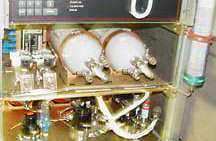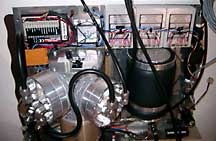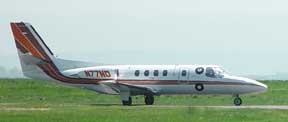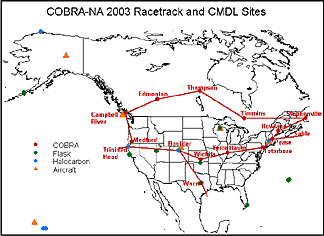 |
|||||||||
skip to content |
|||||||||
Scientists seek data on greenhouse gas emissions
By Barbara McGehan
Government and university scientists will be hanging out at the track this summer – only there aren’t any horses and the track is located 30,000 feet above sea level.
|
The University of North Dakota Cessna Citation aircraft, loaded with instruments, waits on the runway before a flight to measure a variety of greenhouse gas emissions and pollutants over North America. |
Packed with instruments and scientists, the University of North Dakota Cessna Citation aircraft will fly over the central portion of North America in a “racetrack” pattern, measuring greenhouse gas emissions. Researchers plan to measure the concentrations of a variety of gases such as carbon dioxide and sulfur hexafluoride over a major portion of North America, from late May through June 2003. The scientists will combine the aircraft data with high-resolution winds to determine the emission rates for major greenhouse gases over the continent during the month-long experiment.
The flights will also include measurements of ozone-depleting gases and other pollutants from the New York City-Washington, D.C. metropolitan corridor, Denver, Boston, and Dallas. There will be excursions over the Pacific Ocean from Eureka, Calif., and over the Atlantic from Pease, N.H., to Sable Island, to examine coastal influence of marine air and the mixing processes between maritime and continental air.
 |
 |
Some of the equipment that will be used to measure greenhouse gases in the atmosphere, including pollutant carbon monoxide from power plant emissions. |
James Elkins, a researcher at the NOAA Climate Monitoring and Diagnostics Laboratory in Boulder, Colo., and a principal investigator on the project, says “This mission will enable us to map the emissions of both ozone depleting and greenhouse gases across the U.S. and Canada in a way we've never been able to do before.”
Called COBRA (CO2 Budget and Regional Airborne Study), the experiment will also rely upon the extensive ground-based data from NOAA's Cooperative Station Networks for carbon cycle and halocarbon trace gases, the Fluxnet Canada research network and the AmeriFlux network of ground stations. “The flight plan is very ambitious,” said Elkins. “As the aircraft flies over the ground stations, vertical profiles will be taken that will provide important data on the boundary conditions for the flow of air through the area of the racetrack and for atmospheric mixing.” Previous studies have identified a large land area that absorbs CO2 in North America. COBRA will provide a critical test for these ideas.
|
Racetrack for COBRA 2003 experiment and CMDL cooperative stations. (larger image) |
One of the most important problems in forecasting future climate change is to improve predictions of future concentrations of greenhouse gases in the atmosphere. “Currently we lack the capability to accurately measure the sources and sinks of greenhouse gases from large land areas such as North America,” says project scientist Steven Wofsy of Harvard. “This type of measurement is essential for accurate predictions of the future. The COBRA program is designed to make detailed observations in the atmosphere and allow us to determine large-scale sources and sinks.” The racetrack was chosen to encompass a large “sink” of CO2 that occurs over North America during the peak growing season for vegetation.
The project runs until June 23, 2003, and is based at Jefferson County Airport in Broomfield, Colo., and at Pease, N.H. Participants include researchers from the NOAA Climate Monitoring and Diagnostics Laboratory, Harvard University, the National Center for Atmospheric Research, the University of North Dakota, the University of Colorado Cooperative Institute for Research in Environmental Sciences and the Scripps Institution of Oceanography. Scientists at the University of Sao Paulo (Brazil) will collaborate by providing detailed winds and meteorology from their Brazilian Regional Atmospheric Modeling System (BRAMS).
Principal funding is being provided by NASA's Terrestrial Ecology Program, headed by Dr. Diane E. Wickland, with additional funds from NOAA's Climate Monitoring and Diagnostics Laboratory and the Office of Global Programs, NASA's Upper Atmosphere Research and Atmospheric Chemistry Modeling Analysis Programs, the National Science Foundation's Atmospheric Chemistry Program, and the Department of Energy's Terrestrial Carbon Program.
|
NOAA's Climate Monitoring and Diagnostics Laboratory conducts research related to atmospheric constituents that are capable of forcing change in the climate of the Earth or that may deplete the ozone layer. CMDL monitors greenhouse gases, aerosols, ozone, ozone-depleting gases and solar and terrestrial radiation at global sites including four Baseline Observatories. |
[6/16/03]
CLIMATE · OCEANS, GREAT LAKES, and COASTS · WEATHER
and AIR QUALITY
ABOUT US · RESEARCH
PROGRAMS · EDUCATION · HOME

